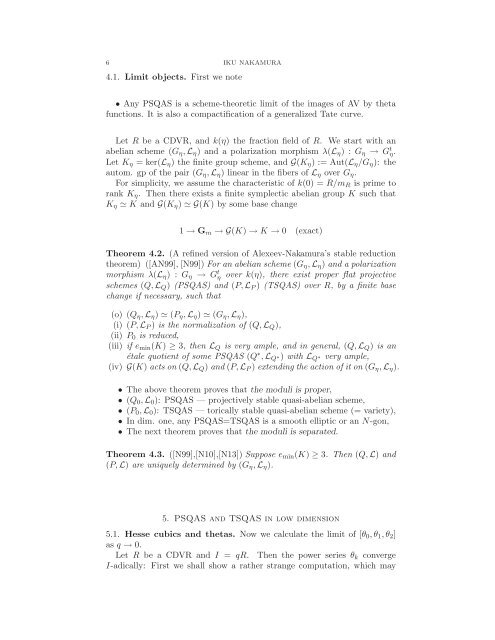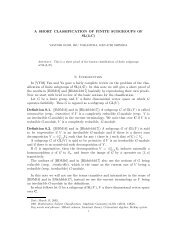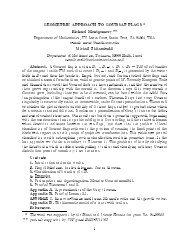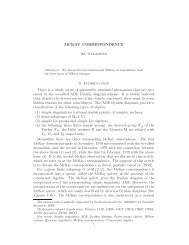Compactification of the moduli space of abelian varieties, Kyoto ...
Compactification of the moduli space of abelian varieties, Kyoto ...
Compactification of the moduli space of abelian varieties, Kyoto ...
Create successful ePaper yourself
Turn your PDF publications into a flip-book with our unique Google optimized e-Paper software.
6 IKU NAKAMURA4.1. Limit objects. First we note• Any PSQAS is a scheme-<strong>the</strong>oretic limit <strong>of</strong> <strong>the</strong> images <strong>of</strong> AV by <strong>the</strong>tafunctions. It is also a compactification <strong>of</strong> a generalized Tate curve.Let R be a CDVR, and k(η) <strong>the</strong> fraction field <strong>of</strong> R. We start with an<strong>abelian</strong> scheme (G η , L η ) and a polarization morphism λ(L η ):G η → G t η.Let K η = ker(L η ) <strong>the</strong> finite group scheme, and G(K η ) := Aut(L η /G η ): <strong>the</strong>autom. gp <strong>of</strong> <strong>the</strong> pair (G η , L η ) linear in <strong>the</strong> fibers <strong>of</strong> L η over G η .For simplicity, we assume <strong>the</strong> characteristic <strong>of</strong> k(0) = R/m R is prime torank K η . Then <strong>the</strong>re exists a finite symplectic <strong>abelian</strong> group K such thatK η ≃ K and G(K η ) ≃G(K) by some base change1 → G m →G(K) → K → 0 (exact)Theorem 4.2. (A refined version <strong>of</strong> Alexeev-Nakamura’s stable reduction<strong>the</strong>orem) ([AN99], [N99]) For an <strong>abelian</strong> scheme (G η , L η ) and a polarizationmorphism λ(L η ) : G η → G t η over k(η), <strong>the</strong>re exist proper flat projectiveschemes (Q, L Q ) (PSQAS) and (P,L P ) (TSQAS) over R, by a finite basechange if necessary, such that(o) (Q η , L η ) ≃ (P η , L η ) ≃ (G η , L η ),(i) (P,L P ) is <strong>the</strong> normalization <strong>of</strong> (Q, L Q ),(ii) P 0 is reduced,(iii) if e min (K) ≥ 3, <strong>the</strong>n L Q is very ample, and in general, (Q, L Q ) is anétale quotient <strong>of</strong> some PSQAS (Q ∗ , L Q ∗) with L Q ∗ very ample,(iv) G(K) acts on (Q, L Q ) and (P,L P ) extending <strong>the</strong> action <strong>of</strong> it on (G η , L η ).• The above <strong>the</strong>orem proves that <strong>the</strong> <strong>moduli</strong> is proper,• (Q 0 , L 0 ): PSQAS — projectively stable quasi-<strong>abelian</strong> scheme,• (P 0 , L 0 ): TSQAS — torically stable quasi-<strong>abelian</strong> scheme (= variety),• In dim. one, any PSQAS=TSQAS is a smooth elliptic or an N-gon,• The next <strong>the</strong>orem proves that <strong>the</strong> <strong>moduli</strong> is separated.Theorem 4.3. ([N99],[N10],[N13]) Suppose e min (K) ≥ 3. Then (Q, L) and(P,L) are uniquely determined by (G η , L η ).5. PSQAS and TSQAS in low dimension5.1. Hesse cubics and <strong>the</strong>tas. Now we calculate <strong>the</strong> limit <strong>of</strong> [θ 0 ,θ 1 ,θ 2 ]as q → 0.Let R be a CDVR and I = qR. Then <strong>the</strong> power series θ k convergeI-adically: First we shall show a ra<strong>the</strong>r strange computation, which may





